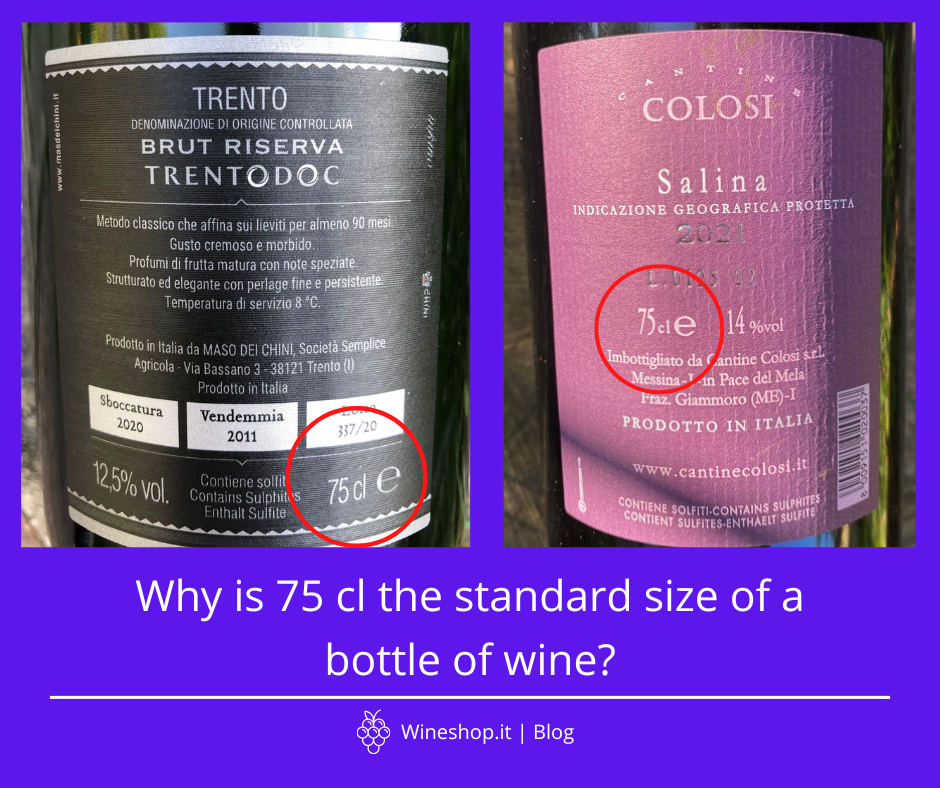Why is 75 cl the standard size of a bottle of wine?
This question tests even the most experienced of wine lovers. The standard capacity of the wine bottles is 75 cl. Everyone knows this, but few enthusiasts know the reasons for this standard.
As often happens, behind these kind of curious questions, there are truly surprising answers. Read our article and you will find the answers to our question.
The capacity of a bottle of wine: 75 cl as an international standard
When in the eighteenth century wine began to be bottled, the capacity of the bottles was variable and there were no common standards to be respected. The first bottles on the market had a capacity between 70 cl and 1 L, depending on the choices of the producers and the skills of the glass blowers who produced them.
Technical innovation and industrialization of the sector ensured a more homogeneous production. In 1975, the European legislator decided that wine could only be marketed in bottles of 25-37.5-50-75 cl up to 1-1.5 L. In order to use bottles of different sizes than those indicated, the various wine regions and their producers must obtain a special permit from the European Union.
Despite all these possibilities, the 75 cl bottle is the most used by world producers. Why?
There is no single answer. Producers give different reasons. The most common are four. We present them to you in the next lines.
1. 75 cl bottles: the size of glass blowers
According to a first hypothesis, it was the ancient glass blowers who established this size. They were able to blow and shape bottles up to 65–75 cl. These were the maximum possibilities guaranteed by their lungs.
The producers chose the format with the maximum capacity, that is 75 cl. These sizes became the most common for glass bottles and were passed down to subsequent generations.
2. 75 cl bottles: 1/6 of a gallon
The second hypothesis takes us to the United Kingdom, where the use of glass bottles for storing wine was experimented for the first time.
Here the liquid capacity was measured in gallons.
In the Anglo-Saxon tradition, wine was transported in boxes of 2 gallons, about 9 liters. Local producers decided that 12 was the ideal number of bottles to market the wine. For this reason, the bottles were produced with a capacity of 75 cl. From a mathematical point of view: 0.75 L x 12 = 9 L.
Even today, boxes for the transport of wine and liquids in the United Kingdom usually contain 12 bottles (2 gallons), while in Italy and in very few other countries they contain 6 bottles (1 gallon).
3. 75 cl bottles: for restaurants and taverns
According to another hypothesis, this capacity was chosen to favor restaurants and taverns. Specifically, 75 cl correspond to about 6 glasses of 125 ml wine, the typical capacity of the traditional tavern glass. In this way, the owners of these places could calculate the number of bottles to uncork, avoiding unnecessary waste.
It was decided for a bottle that contained an even number of glasses: 6 because it seems that, in some areas, it was the maximum number of glasses that could be served!!
4. 75 cl bottles: a question of weight
The last hypothesis concerns the total weight of the wine bottle (glass + wine). To have a standard weight, it was decided to produce a bottle which, when filled with wine, would reach a weight of about 1 kilogram. The glass of a 75 cl bottle and the wine it contained reached this weight.
Today the weight of the bottles is often higher, it depends on the type of glass used. The kilogram is a standard that was followed until the twentieth century.
These 4 hypotheses are the most widespread and are very curious. Do you agree?
If you liked our article and if you want to continue to receive news, updates and curiosities about the world of wine, subscribe to the Wineshop.it wine newsletter. Lots of content and offers await you!









